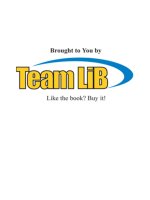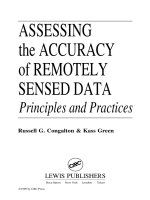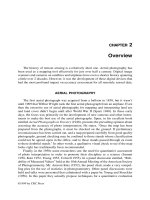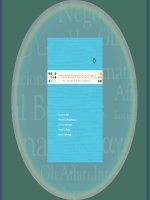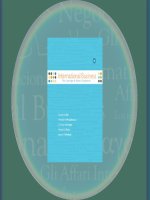International bussiness the challenge of global competition 11e chapter 05
Bạn đang xem bản rút gọn của tài liệu. Xem và tải ngay bản đầy đủ của tài liệu tại đây (358.3 KB, 15 trang )
chapter five
Understanding the
International Monetary System
McGraw-Hill/Irwin
International Business, 11/e
Copyright © 2008 The McGraw-Hill Companies, Inc. All rights reserved.
Learning Objectives
• Explain the functioning of the gold standard
• Describe the purposes of the IMF
• Appreciate the accomplishments of Bretton
Woods system and the ensuing developments
shaping the world monetary system
• Describe the purpose of the World Banks
• Discuss the purpose of the Bank for
International Settlements
5-3
Learning Objectives
• Discuss the floating exchange rate system
• Describe the development of the euro
• Explain the role of the Balance of Payments
(BOP)
• Discuss the major BOP accounts
• Explain the use of Special Drawing Rights
(SDRs)
5-4
Gold Standard
• Gold Standard
– The use of gold at an established number of units
per currency
• Bretton Woods
– The New Hampshire town where treasury and
central bank representatives met near the end of
World War II to establish the IMF, the World Bank,
and the gold exchange standard
5-5
International Monetary Fund
• International Monetary Fund (IMF)
– Institution that coordinates multilateral monetary
rules and their enforcement
• Triffin paradox
– The concept that a national currency that is also a
reserve currency will eventually run a deficit, which
eventually inspires a lack of confidence in the
reserve currency and leads to a financial crisis.
5-6
World Bank
• World Bank
– Institution that focuses on funding of development
projects
• Bank for International Settlements
– Institution that is the central bank for central
bankers
5-7
Currency Exchange Rate Systems
• Fixed currency exchange rates
– Rates that governments agree on and undertake to
maintain
• Floating currency exchanges rates
– Rates that are allowed to float against other
currencies and are determined by market forces
• Jamaica Agreement
– The 1976 IMF agreement that allows flexible
exchange rates among members
5-8
Current Currency Exchange Rate
Arrangements
• Exchange arrangements with no separate
legal tender
• Currency board arrangements
• Other conventional fixed peg arrangements
• Pegged exchange rates within horizontal
bands
5-9
Current Currency Exchange Rate
Arrangements
• Crawling pegs
• Exchange rates within crawling bands
• Managed floating with no preannounced path
for the exchange rate
• Independently floating exchange rates
5-10
Euro
• Currency of the European Union
• 12 EU members have joined the European
Monetary Union
5-11
BOP Accounts
Table 5.1
• Current account
– Records a country’s exports and imports in goods
and services
• Goods or merchandise account
• Services account
• Unilateral transfers
5-12
BOP Accounts
• Capital account
– Records the net changes in a nation’s international
financial assets and liabilities
• Direct investments
• Portfolio Investments
• Short-term capital flows
• Official Reserves account
– Records the assets held by the government; gold,
foreign currencies, and accounts in foreign banks; a
balance of the country’s foreign currency
5-13
Table 5.1 U.S. International
Transactions (millions of dollars)
5-14
Special Drawing Rights
• Special Drawing Rights (SDR)
– An international reserve asset established by the
IMF
– The unit of account for the IMF and other
international organizations
5-15



